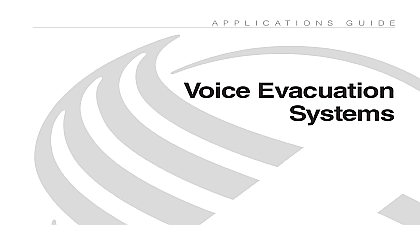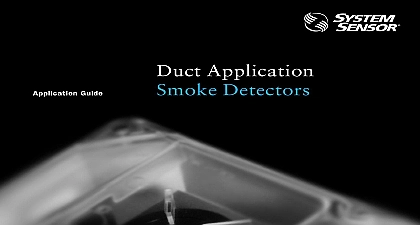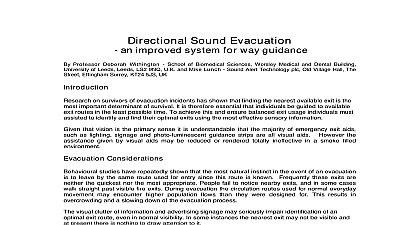System Sensor Voice Evacuation Systems

File Preview
Click below to download for free
Click below to download for free
File Data
| Name | system-sensor-voice-evacuation-systems-7908635214.pdf |
|---|---|
| Type | |
| Size | 933.97 KB |
| Downloads |
Text Preview
A P P L I C A T I O N S G U I D E Evacuation Evacuation 1 Introduction 3 that are controllable by a voice evacuation system designer 8 is the driving factor for voice evacuation systems 3 ratio 8 2 Basics of Sound 3 Frequency Response 7 is sound 3 harmonic distortion 7 does sound travel 3 Placement 8 3 Measuring Sound Output 3 drop on speaker circuits 8 Pressure Level SPL 3 that are not controllable by a system designer 8 4 acoustics 8 Scale 4 the effects of reverberation 9 Scale 4 8 Testing for Intelligibility 9 Scale 4 Methods 9 SPL from two speakers 4 Measurement Methods 9 Rules of Thumb 4 Method Tips and Tricks 9 4 Basics of Speaker Operation 5 Methods When and Where 9 Materials 5 of Intelligibility Meters 9 Impedance 70.7 Volt 25 Volt Distributed Line Systems 5 injection method for test signal 10 5 Basics of Voice Evacuation System Amplifiers 5 Signal Source 10 6 Laws Codes and Standards to Voice Evacuation Systems 5 Guidelines 5 vs Reverberant Chamber 5 Building Code International Fire Code 6 72 The National Fire Alarm and Signaling Code 6 Requirements Per NFPA 72 6 1480 and CAN ULC S541 6 7 Designing for Intelligibility 7 7 to Layout Voice System 7 1 10 2 10 Test Procedure 10 Testing 10 Testing 10 Criteria 10 of Test Methods 11 9 Glossary of Terms 11 10 References 12 GUIDE VOICE EVACUATION SYSTEMSfirealarmresources com 1 purpose of this guide is to provide information about voice alarm sys used in conjunction with fire alarm and emergency communication Voice communications are extensively used to provide build occupant notification during emergencies These messages contain safety information that must be clearly understood by the building the information in this guide is based on years of industry experience is intended to be used only as a guide The requirements of applicable and standards as well as directives of the authority having juris AHJ should be followed In particular the most current version of 72 National Fire Alarm and Signaling Code now requires that voice alarm communications systems be intelligible and dis methods for verifying intelligibility guide provides general information on the concepts of intelligibility the design of emergency voice alarm communications systems It is to provide a better understanding of the factors affecting the intel of these systems in public spaces in order to improve design of that meet the requirements for speech audibility and intelligibility a cost effective manner is the driving factor for voice evacuation systems for mass notification systems had its inception with the of Defense Unified Facilities Criteria UFC document 4 021 the Design and O M Mass Notification Systems evacuation systems are growing in popularity and required in more The events of September 11 2001 were a main driver because they the need to communicate to a large group of individuals out of a fire event That is especially critical for buildings where you have manage the evacuation of complex layouts such as high rise buildings large areas of assembly to these emergency events voice systems would only be used period during fire drills Due to the need for constant communication design and voice message intelligibility are critical it necessary to communicate with occupants regarding a multi of emergencies such as weather threats or toxic gases a traditional tone may not be an ideal signal for non fire events where seek shelter is preferred to evacuation are also moving to the latest editions of the National Fire Alarm Code and building codes which require voice systems in cer occupancies components should be reviewed in order to understand voice 2 of Sound is sound is created by mechanical vibrations that displace air molecules to repetitive changes in air pressure The ear detects these changes in pressure and perceives the magnitude as loudness and the frequency pitch standard ear can hear from a wide range of 20 Hz through 20,000 Hz 1 children to 25Khz years and up to 20KHz to 16KHz adults on lifetime noise exposure frequencies range from 500Hz to 4,000 Hz does sound travel air molecules themselves don move very far They simply transfer pres changes into sound waves Sound waves move away from the sound such as a speaker at a speed determined by the sound source more power the source emits the wider the sound waves spread In the further out the sound waves travel from the source the less they become waves are regularly intercepted by other sound waves Imagine children jumping into the water at the same time their waves overlap when a sound wave is intercepted by an outside force a portion reflected into a different direction As a result before installing a voice system it imperative to understand sound output and the way waves reflect and interact 3 Sound Output Pressure Level SPL is the difference between the pressu


